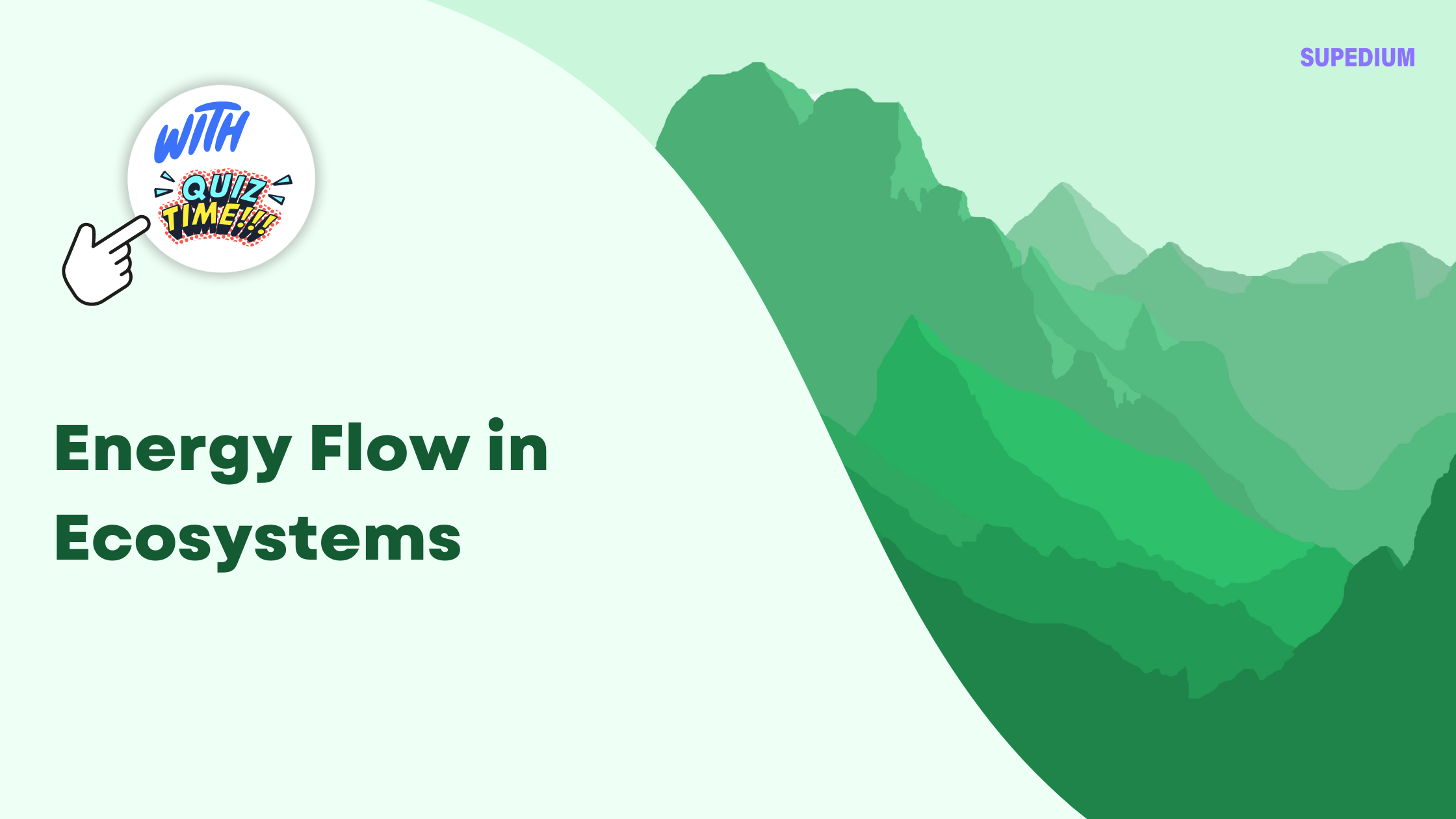Table of Contents
![]()
Introduction
Ecosystems, complex networks of biotic (living) and abiotic (non-living) components, operate through intricate interactions that maintain ecological balance and support life. Central to these interactions is the concept of energy flow, which is fundamental for ecosystem functioning. Energy flow describes how energy is transferred from one part of the ecosystem to another and how it influences biotic interactions, ecosystem stability, and productivity.
Basic Concepts of Energy Flow
Energy Source: The Sun
The primary source of energy for almost all ecosystems is solar energy. The process begins with photosynthesis, where green plants, algae, and some bacteria convert sunlight into chemical energy. This energy is captured in the form of glucose, which is used by these organisms to grow and reproduce. Photosynthesis is thus the foundation of energy flow in ecosystems, providing the energy necessary for all other trophic levels.
Trophic Levels
Energy flow through ecosystems is organized into trophic levels, which are categorized as follows:
- Producers (Primary Producers): These are autotrophic organisms, such as plants and algae, that synthesize their own food using sunlight, water, and carbon dioxide. They serve as the base of the food chain and are responsible for converting solar energy into a form usable by other organisms.
- Consumers: These are organisms that obtain energy by consuming other organisms. They are further categorized into:
- Primary Consumers (Herbivores): Animals that feed directly on producers. Examples include deer and insects.
- Secondary Consumers (Carnivores and Omnivores): Animals that feed on primary consumers. Examples include wolves and birds.
- Tertiary Consumers (Top Predators): These are apex predators that occupy the highest trophic level and feed on secondary consumers. Examples include eagles and sharks.
- Decomposers and Detritivores: These organisms break down dead plants and animals, recycling nutrients back into the ecosystem. Examples include fungi, bacteria, and earthworms. They play a critical role in nutrient cycling and energy flow by decomposing organic matter and returning nutrients to the soil.
Energy Transfer and Efficiency
Energy Transfer Between Trophic Levels
Energy transfer between trophic levels is depicted through an energy pyramid. At each level, energy is transferred from one trophic level to the next, but only about 10% of the energy is passed on. The rest is lost primarily as heat through metabolic processes. This loss of energy means that there are fewer organisms and less biomass at higher trophic levels, resulting in a pyramid-like structure.
Energy Flow Diagrams and Food Webs
- Food Chains: Represent simple, linear pathways of energy flow from producers to consumers. For example, grass → rabbit → fox.
- Food Webs: More complex and realistic representations of energy flow, showing interconnected food chains and interactions between different organisms. Food webs provide a more comprehensive picture of energy flow within an ecosystem.
Ecological Pyramids
- Pyramid of Numbers: Illustrates the number of organisms at each trophic level. It can be inverted in certain ecosystems, such as when a single tree supports a large number of insects.
- Pyramid of Biomass: Shows the total biomass (weight of living organisms) at each trophic level. It typically decreases as one moves up the trophic levels.
- Pyramid of Energy: Demonstrates the energy available at each trophic level. It is always upright, reflecting the decrease in energy as one moves up the food chain.
Factors Affecting Energy Flow
Environmental Conditions
Various environmental factors can influence energy flow within an ecosystem. Climate and weather patterns affect primary productivity and the availability of resources. Soil and water quality impact the health and productivity of producers, which in turn affects the entire food web.
Biological Factors
Species diversity and abundance influence energy flow. A diverse ecosystem with many species can have more complex food webs and more efficient energy transfer. Interactions such as predation and competition also affect how energy is distributed and utilized among organisms.
Human Impacts
Human activities have significant impacts on energy flow in ecosystems. Habitat destruction disrupts energy flow by eliminating producers and altering food webs. Pollution can affect the health of organisms and the efficiency of energy transfer. Climate change can alter temperature and precipitation patterns, impacting primary productivity and species distribution. Invasive species can outcompete native species, leading to imbalances in energy flow and ecosystem function.
Energy Flow in Different Ecosystem Types
Terrestrial Ecosystems
- Forests: Forest ecosystems are characterized by high biodiversity and high primary productivity. They have complex food webs with many trophic levels and high energy flow. Forests also play a crucial role in regulating global climate and carbon cycles.
- Grasslands: Grasslands have lower primary productivity compared to forests but support large herbivore populations. They are adapted to seasonal variations and are crucial for supporting grazing animals and maintaining soil health.
- Deserts: Deserts have low primary productivity due to limited water availability. Energy flow is less complex, with fewer trophic levels and lower biomass. Desert organisms are adapted to extreme conditions and efficient energy use.
Aquatic Ecosystems
- Freshwater (Lakes and Rivers): Freshwater ecosystems have distinct energy flow patterns compared to terrestrial ecosystems. They often have simpler food webs and can be highly productive, especially in nutrient-rich waters. Phytoplankton serve as the primary producers in these ecosystems.
- Marine (Oceans and Coral Reefs): Marine ecosystems, including oceans and coral reefs, exhibit high biodiversity and productivity. Coral reefs, in particular, have complex food webs and high energy flow due to their diverse communities and symbiotic relationships.
Intertidal and Estuarine Zones
Intertidal and estuarine zones have unique energy dynamics due to their position between land and sea. These areas experience regular tidal influences and are rich in nutrients, supporting diverse and productive ecosystems. They play a key role in nutrient cycling and energy transfer between terrestrial and marine environments.
Case Studies and Examples
Tropical Rainforest Ecosystems
Tropical rainforests are known for their high biodiversity and complex food webs. They exhibit high primary productivity due to abundant sunlight and rainfall. The intricate interactions among species and the rapid decomposition of organic matter contribute to a highly efficient energy flow.
Arctic Tundra Ecosystems
The Arctic tundra has low primary productivity due to extreme cold and short growing seasons. Energy flow in tundra ecosystems is characterized by simple food webs and low biomass. Organisms are adapted to survive in harsh conditions and utilize energy efficiently.
Coral Reef Ecosystems
Coral reefs are among the most productive marine ecosystems, supported by the symbiotic relationship between corals and zooxanthellae (photosynthetic algae). This relationship enhances energy flow and supports a diverse array of marine life, making coral reefs highly productive and dynamic ecosystems.
Conclusion
Energy flow in ecosystems is a crucial concept for understanding how ecosystems function and maintain balance. It influences species interactions, ecosystem stability, and productivity. Recognizing the importance of energy flow helps in managing and conserving ecosystems effectively. Ongoing research and conservation efforts are essential to address the impacts of human activities and ensure the sustainability of ecosystems and their energy dynamics.






Be the first to comment